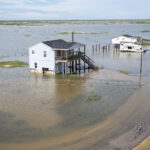Until recently, homeowners insurers weren’t allowed to use catastrophe models to justify needed rate increases, or to include the cost of reinsurance in their rate indications in the state of California.
While that changed late last year when Commissioner Ricardo Lara announced new regulations allowing both as part of his Sustainable Insurance Strategy, carriers don’t like the tradeoff they’re being asked to agree to in order to take advantage of the reforms, a trade group representative said last week.
Related articles: California Commissioner Announces Regulation to Enable the Use of Modeling in Rates; California Commissioner Issues Regulation to Allow Reinsurance in Ratemaking
“There’s a quid pro quo if you want to use cat modeling and the cost of reinsurance. You’ve got to commit to write 85 percent of your business in high hazard areas,” said Eric Goldberg, department vice president and counsel, Commercial Lines, at the American Property Casualty Insurance Association. “We’ve got about 1,200 members, and none of them that I’ve spoken to are interested in this kind of an approach at all,” he said.
Litigation Landscape: State-by-State
Goldberg was speaking at the S&P Global Ratings 41st Annual Insurance Conference last week during a session on tort and regulatory challenges, which included the presentation of state-by-state data insights from Tim Zawacki, principal research analyst at S&P Global Market Intelligence.
Zawacki focused on the judicial and legislative landscapes in various states—and the positive impacts of tort reform in Florida, in particular—before the session’s moderator, Saurabh Khasnis, director and lead analyst at S&P Global Ratings, turned to Goldberg to ask about regulatory impediments to restoring health to California’s insurance market.
“You just can’t take your eye off the ball,” Zawacki said, summing up his presentation of the evolving tort landscape across the nation. “Just one decision, one piece of legislation can really move the needle significantly for the industry,” he said, referring to the incredible task that executives like Goldberg and another panelist, Richard Loconte, senior vice president, government and industrial relations at Allstate, face on a daily basis.
Among the facets of state legal systems that S&P GMI considered in a recent analysis were the different state regimes in place for appointments vs. elections of judges, controlling parties in the houses of state legislatures, and precedent-setting judicial outcomes that can drive material adverse reserve development for the industry.
Offering examples related to the medical malpractice line, Zawacki displayed 2024 loss and DCC (defense and cost containment) ratios for Oregon (81.2) and Pennsylvania (99.1), each sitting at least 10 points above the countrywide ratio (71.8). He explained that the Oregon Supreme Court struck down a $500,000 cap on noneconomic damages in 2020. And in Pennsylvania, a court ruling “cleared the way for venue shopping in medical malpractice cases” a few years ago—prompting most claimants to choose the plaintiff-friendly Philadelphia Court of Common Pleas.
Tort reforms passed in Iowa and Florida have had the opposite effects, he said, prompting Khasnis to ask Zawacki to specifically hone in on insurance market impacts of Florida’s 2023 reforms restricting assignment of benefits agreements and eliminating one-way attorney fees.
Related Insurance Journal articles include: Florida Bills Offer Broad Attack on Insurance Costs: Legal Fees, AOBs, Reinsurance; Fla. Tort Bill Brings it: Limits Damages, Ends Fee Multipliers, Discloses LOPs – and More
In response, Zawacki displayed a comparative analysis of auto liability loss ratios for 2021-2024 for the states of Florida, California, New Jersey and New York. While Florida’s loss and DCC ratio for the line (personal and commercial auto liability together) fell from a high of around 100 in 2022 to just over 63 in 2024, comparable 2024 ratios in the other three states still hover near 100.
Auto liability, Zawacki said, is a line where Florida had been known for nuclear verdicts—of $10 million or more—for commercial auto, in particular. “While there still are large verdicts in the state of Florida that pop up, … the frequency of those large verdicts has materially declined since the institution of tort reform in 2023.”
Turning to residential property insurance, Zawacki displayed a graph with property combined ratios (for the homeowners, dwelling fire and allied lines) for the top 10 Florida domestic insurers over the last eight years. The ratios rose from 101-102 in 2017- 2019 to a high of 117.8 in 2020, and ultimately declined to 90.6 in 2024.
He highlighted AOB reform as a driver of change. Referring to water loss claims associated with Hurricane Irma in 2017, prior to the reforms, he said, that “assignment of benefits [to contractors] was emblematic of the unique element of the Florida system that allowed many of these cases to end up in court and settle at high levels….”
In the last two years, combined ratios “improved materially relative to that post-Irma environment,” even with hurricanes like Helene and Milton making landfall. “That’s due to the strength of reinsurance, but it’s also due to significant improvement in the defense and cost containment expense ratio in these lines of business in Florida. We’ve seen a material reduction in defense and cost containment expenses,” he stated.
Zawacki’s combined ratio analysis excluded Citizens Property Insurance Corporation. Noting that another motivation of reforms was to depopulate the market of last resort, Zawacki displayed a graph of “policies removed” for each year from 2017-2024. The number sat near 0 from 2017-2022. “Depopulation had almost evaporated in that post-Irma environment. Companies just weren’t willing to take on material exposure given the risks [of] litigated claims.”
In the last two years, depopulated policy counts “skyrocketed,” Zawacki reported. The graph showed a level nearing 500,000 removed for 2024. In addition, he said more than 160,000 policies have already been depopulated from Citizens in 2025.
What About California?
Khasnis then asked Goldberg what’s going on with California’s insurer of last resort—the FAIR Plan—noting that California’s problems are centered on wildfire losses and insurance pricing inadequacy.
“California’s insurance market right now is in a crisis,” Goldberg said. “Speaking for the industry,….we’re committed to the businesses and the citizens of California…. But the system is anachronistic,” he said, referring to Proposition 103, California’s decades-old prior approval law for insurance rates, which also established a mechanism for consumer groups to intervene in the approval process.
When Prop 103 was put on the books in the late 80s, “that was back when carriers were filing the rating plans in a three-ring binder. The world has changed and it doesn’t work anymore,” Goldberg said. “We commend Commissioner Lara and the department for taking the initiative to move forward. But there are a lot of problems.”
“There’s this narrative that’s being pushed that weather is not insurable,” he continued. “It’s not the weather. We can underwrite and we can price for weather. It’s all of the other external factors, the increased costs of building materials and labor, nuclear verdicts and all of the other factors that are drive up costs,” Goldberg said.
“What does California really need to do? They need to reform the FAIR Plan,” he added. “The FAIR Plan is growing exponentially. It’s not getting better. They just adopted rules raising the limits for commercial properties in the FAIR Plan. What that’s going to do, likely, is drive commercial insurers out of the market, because they don’t want to be subject to assessments.”
Goldberg said “unsustainable coverage mandates” are another problem in California, noting, for example that the “department put a lot of pressure on carriers to pay 100 percent of contents limits without a requirement that inventory be provided….”
“Smoke damage claims are a big threat right now. Companies are seeing smoke damage claims from policyholders [who are] 75 miles away from where the fire took place,” he asserted.
Related article: CDI Announces Investigation of State Farm Wildfire Claims Handling
On the pricing front, Goldberg then went on to make his observation about insurers’ reactions to the requirements associated with ratemaking reforms addressing the use of catastrophe models and reinsurance cost provisions. At a separate session, “The Future of Insurance in an Era of Extreme Perils,” Dr. Julia Borman, an assistant vice president of Regulatory and Rating Agency Client Services for Verisk, spoke about all the effort her firm has put into getting cat models approved in California.
“Verisk has been talking to California about modeling for eight years. We have been to the department. We were in front of the legislators. We were part of the conversations with the trades. It took a long time. And then at the top of this year, we had the Sustainable Insurance Strategy in full. And we finally had a way to have our cat model reviewed.”
“We showed up for it January 2nd when it opened. But it takes time,” she said.
Goldberg said rate approvals have been taking time too. “Nobody got rate for two years,” he said, referring to a period of time right after the pandemic. “The industry is constantly lagging, trying to make up rate for increases in losses, increases in inflation and so forth.”
Now, he believes “California realizes it’s got an issue.” And regulatory change is moving in the right direction. “But a lot more needs to be done in order to make California a more attractive place to do business.”
Rate Change Data
Offering data from S&P GMI’s RateWatch tool, Zawacki displayed aggregate approved rate changes across various states in the private passenger auto and homeowners lines from January 2024 through May 2025, ranked by the largest in each line. New Jersey and California topped the auto list with more than 20 percent each, compared to just 8.7 percent across the nation. For homeowners, Iowa, Nebraska, Colorado, Minnesota, Wisconsin and Kentucky all had 20 percent-plus cumulative rate increases over the same time period, compared to 14.7 percent countrywide.
Many states on the homeowners list, in the upper Midwest, have been hard hit by severe convective storms and the pressures in the reinsurance market, Zawacki said. Carriers are trying to catch up to the storm losses “that are just large and getting bigger with every successive year,” Zawacki said.
He observed that a common theme for states with large auto insurance increases in 2024 and 2025 is that they are prior-approval states where regulators must explicitly sign off on filed rate changes. “This isn’t necessarily a critique of prior approval statutes. It’s just the reality of the timeline associated with them,” he said, suggesting that insurers were able to raise auto rates in other states more quickly—in 2022 and 2023, in response to rising loss severity trends.
Highlighting New Jersey, where the 2024 private auto liability loss ratio of 95 is the highest in two decades and 20 points above the national average, Zawacki noted that the Garden State is like California in that both have an intervenor process, and both states also allow carriers to request a modest rate increase through a limited rate filing process in order to get rate hikes into the market more quickly. “It may not be anywhere close to your indicated rate, but it’s something,” he said, also noting, however, that back-and-forth between N.J. regulators and carriers can play out here too—and “all of a sudden this expedited approval process is more like a normal timeline.”
“If companies aren’t able to get rate changes to market to reflect the inflationary pressures, then the problem only snowballs,” he said, also noting that New Jersey has unique challenges with staged accidents and fraud that aren’t being reflected in rates customers are being charged.
Others Perspectives
Carrier executives speaking at other sessions of S&P two-day conference also weighed in on rate adequacy and regulatory challenges.
Participating on a panel of P/C chief executive officers, Juan Andrade, president and CEO of USAA, was asked for his outlook on personal lines insurance for the next 12-24 months. “It’s probably a tale of two cities….The automobile insurance sector is in a healthier place now than it certainly was two or three years ago. That’s the result of the rate increases that I think we all have had to take over that period of time.” Homeowners—is “the other side of the coin….There’s still a lot of work that needs to get done from a regulatory standpoint, from a pricing standpoint, and from a risk mitigation standpoint.”
Asked specifically about the current regulatory environment at a different session, Alan Schnitzer, chair and CEO of The Travelers Companies said, “There are a small number of states that are problematic from a regulatory perspective. The problem is there are lots of people living in a small number of states. So the problem is disproportionate to the number of states involved.”
He continued, “It’s not that complicated. We need states and we need regulators to support risk-based pricing,” referring to California as “the poster child for this.”
“Fundamentally, the way this industry works is people pool capital to support each other in managing risk. And the amount of capital you pay into that should be a function and reflection of your risk.”
“When we have artificial barriers to risk-based pricing, it undermines the whole business model, and either you get a lack of capacity in jurisdictions or you get cross-subsidizations that people get unhappy about.”
During the session on extreme perils, Frances O’Brien, executive vice president and chief risk officer for Chubb Group, also called out the regulatory challenges in California when asked about her company’s approach to balancing goals of maintaining financial stability and market relevance. “What’s happening in California before the fires, and now after the fires, is a really interesting study in how regulators can cause an availability issue in their market,” she said.
“When you have a regulatory regime where…you can’t get granular pricing, or you can’t get proper terms and conditions, or you can’t use tools like models to allow you to say, ‘This is my risk,’ then naturally the capacity in the admitted market shrinks,” she said.
The growth of an inadequately funded FAIR Plan creates the potential for assessments to admitted carriers—another factor in the retreat of admitted markets. “I don’t want to offer [capacity] because then I have to pay more assessments,” O’Brien said, noting that Chubb instead has offered more capacity in the excess and surplus lines space in California.
“We do want to be in the marketplace, but we have to have…a reasonable [likelihood] of generating a return. And I think there are a lot of other companies like that,” she said, referring to the greater freedom of rate and form available in the E&S market.
“Compare that to what Florida did in the 90s and 2000s when they lost all the capacity in their market, and…look at what’s happening in that market today. Now, it took many, many years, [but] there’s a lot of capacity going into that market” today. “So, it is something that can be reversed depending on the wherewithal of the state legislature and the regulators in the state.”
“It’s really night and day,” agreed Erin Kang, chief underwriter for the Regional & Specialty and Mutual Practice of reinsurer Gen Re, contrasting California with Florida, and confirming that she sees more reinsurance opportunities coming her way on the E&S side.
Work in Florida Continue
Speaking at the session on regulation and tort reform, Allstate’s Loconte said that government affairs representatives of insurers continue their work in Florida, even after 2023’s tort reforms were enacted. “We probably put as much time, energy and resources into…keeping those reforms in place [during] this last [legislative] session….”
The reforms significantly increased competition in the market, he said, counting about a dozen new entrants into the Florida market in the last few years.
“We have been able to either hold rates steady or in some cases drop [them] on the auto side,” he added, noting that the benefits to policyholder have become evident in a relatively short time period.
But “it’s s not like we got the win [and] we moved on” to another state, he said, noting that a different governor will be in place in Florida at some point, and a lack of stability in the state legislature. The trial bar traditionally supported Democrats, but now “a more populous Republican party that is also likely to support the trial bar. “That’s certainly another challenge. It makes things a little more chaotic,” Loconte said.
Was this article valuable?
Here are more articles you may enjoy.

 Waymo to Update Software Across Fleet After Major Power Failure
Waymo to Update Software Across Fleet After Major Power Failure  Apollo Expands Asset-Level Risk Reviews to Reflect Impact of Extreme Weather
Apollo Expands Asset-Level Risk Reviews to Reflect Impact of Extreme Weather  Flooding in California Leads to Soaked Roads, Water Rescues and 1 Death
Flooding in California Leads to Soaked Roads, Water Rescues and 1 Death  J&J Talc Jury Awards $1.56 Billion to Asbestos Cancer Victim
J&J Talc Jury Awards $1.56 Billion to Asbestos Cancer Victim 